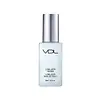What's inside
What's inside
 Key Ingredients
Key Ingredients

 Benefits
Benefits

 Concerns
Concerns

 Ingredients Side-by-side
Ingredients Side-by-side

Hydrogenated Polydecene
EmollientHydrogenated Polyisobutene
EmollientRicinus Communis Seed Oil
MaskingEthylene/Propylene Copolymer
AbrasiveEthylhexyl Olivate
Skin ConditioningPolyglyceryl-4 Diisostearate/Polyhydroxystearate/Sebacate
EmulsifyingParfum
MaskingCaprylyl Glycol
EmollientDiisostearyl Malate
EmollientArgania Spinosa Kernel Oil
EmollientOctyldodecyl Stearoyl Stearate
EmollientEthylhexylglycerin
Skin ConditioningPersea Gratissima Oil
Skin ConditioningCI 77891
Cosmetic Colorant1,2-Hexanediol
Skin ConditioningCI 77007
Cosmetic ColorantCI 77491
Cosmetic ColorantHydrolyzed Hyaluronic Acid
HumectantHydrogenated Polydecene, Hydrogenated Polyisobutene, Ricinus Communis Seed Oil, Ethylene/Propylene Copolymer, Ethylhexyl Olivate, Polyglyceryl-4 Diisostearate/Polyhydroxystearate/Sebacate, Parfum, Caprylyl Glycol, Diisostearyl Malate, Argania Spinosa Kernel Oil, Octyldodecyl Stearoyl Stearate, Ethylhexylglycerin, Persea Gratissima Oil, CI 77891, 1,2-Hexanediol, CI 77007, CI 77491, Hydrolyzed Hyaluronic Acid
Water
Skin ConditioningCyclopentasiloxane
EmollientCyclohexasiloxane
EmollientNeopentyl Glycol Diethylhexanoate
EmollientButylene Glycol
HumectantPEG-10 Dimethicone
Skin ConditioningSynthetic Fluorphlogopite
Glycerin
HumectantDipropylene Glycol
HumectantCI 77891
Cosmetic ColorantMagnesium Sulfate
Dimethicone Crosspolymer
Emulsion StabilisingSorbitan Sesquiisostearate
EmulsifyingPanthenol
Skin ConditioningDisteardimonium Hectorite
StabilisingPhenoxyethanol
Preservative1,2-Hexanediol
Skin ConditioningDistearyldimonium Chloride
Tocopheryl Acetate
AntioxidantStearic Acid
CleansingTin Oxide
AbrasiveAlpha-Isomethyl Ionone
PerfumingBenzyl Benzoate
AntimicrobialCitronellol
PerfumingLimonene
PerfumingHexyl Cinnamal
PerfumingLinalool
PerfumingHydroxyisohexyl 3-Cyclohexene Carboxaldehyde
MaskingButylphenyl Methylpropional
PerfumingParfum
MaskingWater, Cyclopentasiloxane, Cyclohexasiloxane, Neopentyl Glycol Diethylhexanoate, Butylene Glycol, PEG-10 Dimethicone, Synthetic Fluorphlogopite, Glycerin, Dipropylene Glycol, CI 77891, Magnesium Sulfate, Dimethicone Crosspolymer, Sorbitan Sesquiisostearate, Panthenol, Disteardimonium Hectorite, Phenoxyethanol, 1,2-Hexanediol, Distearyldimonium Chloride, Tocopheryl Acetate, Stearic Acid, Tin Oxide, Alpha-Isomethyl Ionone, Benzyl Benzoate, Citronellol, Limonene, Hexyl Cinnamal, Linalool, Hydroxyisohexyl 3-Cyclohexene Carboxaldehyde, Butylphenyl Methylpropional, Parfum
Alternatives
Ingredients Explained
These ingredients are found in both products.
Ingredients higher up in an ingredient list are typically present in a larger amount.
1,2-Hexanediol is a synthetic liquid and another multi-functional powerhouse.
It is a:
- Humectant, drawing moisture into the skin
- Emollient, helping to soften skin
- Solvent, dispersing and stabilizing formulas
- Preservative booster, enhancing the antimicrobial activity of other preservatives
Ci 77891 is a white pigment from Titanium dioxide. It is naturally found in minerals such as rutile and ilmenite.
It's main function is to add a white color to cosmetics. It can also be mixed with other colors to create different shades.
Ci 77891 is commonly found in sunscreens due to its ability to block UV rays.
Learn more about CI 77891Parfum is a catch-all term for an ingredient or more that is used to give a scent to products.
Also called "fragrance", this ingredient can be a blend of hundreds of chemicals or plant oils. This means every product with "fragrance" or "parfum" in the ingredients list is a different mixture.
For instance, Habanolide is a proprietary trade name for a specific aroma chemical. When used as a fragrance ingredient in cosmetics, most aroma chemicals fall under the broad labeling category of “FRAGRANCE” or “PARFUM” according to EU and US regulations.
The term 'parfum' or 'fragrance' is not regulated in many countries. In many cases, it is up to the brand to define this term.
For instance, many brands choose to label themselves as "fragrance-free" because they are not using synthetic fragrances. However, their products may still contain ingredients such as essential oils that are considered a fragrance by INCI standards.
One example is Calendula flower extract. Calendula is an essential oil that still imparts a scent or 'fragrance'.
Depending on the blend, the ingredients in the mixture can cause allergies and sensitivities on the skin. Some ingredients that are known EU allergens include linalool and citronellol.
Parfum can also be used to mask or cover an unpleasant scent.
The bottom line is: not all fragrances/parfum/ingredients are created equally. If you are worried about fragrances, we recommend taking a closer look at an ingredient. And of course, we always recommend speaking with a professional.
Learn more about Parfum